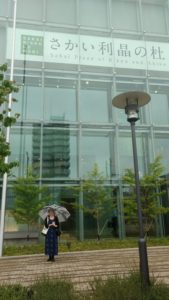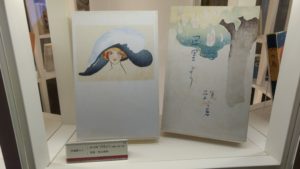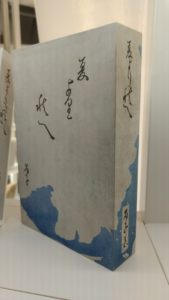
By the time you read this, I will likely already be in Russia. But I started drafting this post in Japan, on the shinkansen (bullet train) after leaving Osaka on Thursday, June 22, to wend my way north and west toward the port town of Sakaiminato.
I included Osaka on my itinerary because Yosano Akiko, the subject of my next novel, was from the nearby city of Sakai. The house where she was born in 1878 is no longer there, but there’s a site on one of the main thoroughfares in the city that indicates where it used to be. I paid my respects on a rainy afternoon. The poem on the plaque reads:
海こいし潮の遠鳴りかぞえては少女となりし父母の家
Umi koishi shio no tō nari kazoete wa otome to narishi chichi haha no ie
My translation attempt:

Of more interest than the birthplace marker is the Yosano Akiko Museum, just a block or two south. Established sometime in the last few years, the Sakai Rishō no Mori [site in Japanese]](堺利晶の杜, which they’ve translated a bit oddly as “Sakai Plaza of Rikyū and Akiko”) actually houses two museums, one devoted to Sen no Rikyū, the 16th-century tea ceremony master, and the other, upstairs, to Akiko.
I don’t know that I learned new facts of her life (which was reassuring, as it suggests I’ve done my homework). But I saw things I’d never seen before, like photos not found on the Internet or in the biographies I’ve consulted, as well as gorgeous first editions of her many publications.

Here are photos of three publications of particular interest to me: The first is volume one of her four-volume translation into modern Japanese of The Tale of Genji, Murasaki Shikibu’s sprawling 10th-century tale of the lives and loves of Heian Period courtiers. Genji would be an artistic and personal touchstone for Akiko throughout her life. She rushed the first two volumes to press in the months before she left for Europe; the publication no doubt helped fund her trip.

The second book is Pari yori [パリより, From Paris], a non-fiction memoir of the trip co-written with her husband Hiroshi, who had gone to Paris six months ahead of Akiko. I believe this book may include (or may even be wholly comprised of) dispatches the famous literary couple sent from Paris and that first appeared in the Tokyo-based Asahi shimbun newspaper.


And the third book is Natsu yori aki e [夏より秋へ; Summer to Autumn], Akiko’s 1913 poetry collection, which includes over 200 poems Akiko composed about her journey. I’ve spent much of the last year translating these into English. Partly it’s research; Akiko recorded many of her impressions about the trip in her poems. And partly it’s to provide my new novel with epigraphs. Here’s a sample poem from the collection, along with my own attempt at translation:
恋するにむつかしきこと何のこる三千里さへ一人にて来し
Koi suru ni mutsukashiki koto nani nokoru sanzen-ri sae hitori ni te koshi
The museum also has a short, soundless video of Akiko holding one of her grandchildren. Honestly, she looks too young to be a grandmother already, but I may be projecting how old I’m likely to be before I have any grandchildren myself. Akiko’s dressed in kimono and looks happy. The baby is bundled in many layers and wears an expression of great infant seriousness.
It’s odd to see film footage of someone who’s been gone a long time and that you only know through scholarship and photographs. It reminded me of being at the Jack London Museum in Glen Ellen, California, where one can watch (or could, anyway, when I visited more than 15 years ago) a short film of Jack London, taken shortly before he died in 1916. There they are, preserved in black and white, so much alive yet out of reach.
Even eerier, I think, is hearing the voice of a famous deceased person who’s not, you know, a film actor. The Akiko museum has two such recordings. In the first, she’s reading from her own translation of The Tale of Genji. I believe this is a recording she completed in the 1930s at the Columbia Records office in Tokyo.
In the other, she’s reciting her own poetry. But it’s not really a recitation or reading so much as chanting. The “tune” follows a pattern of rising and falling tones that’s repeated for each poem.
It put me in mind of plainchant, which I sang some during my years with the Holy Innocents Episcopal Church choir in San Francisco. Once you know the pattern, you can apply it to any Psalm. Likewise Akiko’s chanting sounded as though it might be applied to any tanka [短歌], the common Japanese poetic form that consists of 31 syllables arranged in sets of 5-7-5-7-7. Akiko wrote in many different poetic forms during her very productive life. But tanka comprise the chief part of her oeuvre.
I felt a rush of emotion on hearing Akiko’s voice that I did not feel anywhere else—not standing on the site of her birthplace or seeing old family photos I had not seen before or watching her show off her new grandchild for the camera. There was something so intimate about holding the handset to my ear and hearing her. And something daunting about it too. Would I—could I—do right by that voice?
I’m certainly going to try. Meanwhile, I’m off for the next stage of my own journey. As I complete this blog entry, I’m on the ferry for Vladivostok. I was most anxious about this segment of the trip, but so far it’s been fine; I’ll try to write about it soon.
It was raining lightly as I boarded yesterday evening, so I’ll leave you with this poem from Akiko’s Summer to Autumn:
傘あけてわれかしずきぬ島の人船を上れば銀の雨ふる
Kasa akete ware kashizukinu shima no hito fune o agareba gin no ame furu
I’m impressed, Naomi! I had much the same sort of feeling when I first heard the one (short) available recording of Sigmund Freud speaking.
Continued good luck on your expedition.
Alan
Freud?! Wow. Thanks for reading my post, Alan!
Naomi, this is so exciting. I’m looking forward to your book about Yosano Akiko. Seeing and being where she lived must be unimaginably exciting. If I were in your place I would be jumping up and down in ecstasy (if my aching 71 yr old knee would permit it). Your journey brings up so many memories of my own family. Is Vladivostok somewhat close to the island of Tsu Shima? A famous naval battle between Japan and Russia happened there in 1905. I had a grandfather who served on a warship at that time as a wireless operator. Also my 93 yr old aunt (Yamamoto Koho) writes tanka, she survived cancer twice and is going strong in New York City. I am anticipating hearing more as you continue your journey. I am thrilled. Arthur
Hi, Arthur, and thanks for following my progress around the world. I love the stories you’ve shared.
Those book covers are gorgeous! What inspiration for your–I wish mine could look like those.
Right? Me too!
This was lovely. I’m enjoying your journey so much.
Thanks for reading!
Reblogged this on Lincoln Life Blog.